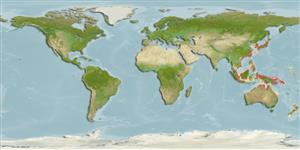Common names from other countries
Classification / Names / Names
Namen | Synonyme | Catalog of Fishes (gen., sp.) | ITIS | CoL | WoRMS
Environment: milieu / climate zone / depth range / distribution range
Ökologie
; brackwasser. Tropical
Western Pacific.
Length at first maturity / Size / Gewicht / Alter
Maturity: Lm ? range ? - ? cm Max length : 92.0 cm TL Männchen/unbestimmt; (Ref. 122452)
The horseshoe crab body is divided into three parts: the front dome-shaped prosoma, the middle marginally-spined opisthosoma, and the rear spike-like telson. The width of the prosoma is commonly in estimating the age and growth stages since it can be measured easily and yields the smalles errors in measurement (Ref. 127127).
Chiu, H.M.C. and B. Morton. 2004. (Ref. 408)
IUCN Rote Liste Status (Ref. 130435: Version 2024-1)
CITES Status (Ref. 108899)
Not Evaluated
Not Evaluated
Bedrohung für Menschen
Poisonous to eat (Ref. 130560)
Nutzung durch Menschen
| FIRMS (Stock assessments) | FishSource |
Tools
Mehr Information
NamenSynonymeRäuberFortpflanzungGeschlechtsreifeAblaichenFecundityEierEientwicklung
Internet Quellen
Estimates based on models
Verwundbarkeit
High vulnerability (57 of 100).
Preiskategorie
Unknown.
